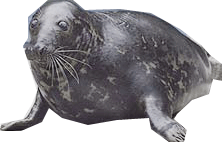Gray Seal

Scientific Classification
Kingdom: Animalia
Phylum: Chordata
Class: Mammalia
Order: Carnivora
Family: Phocidae
Genus: Halichoerus
Species: grypus
Introduction
Gray seals are part of the "true seal" family, Phocidae. True seals lack external ear flaps and have short forelimbs that result in limited locomotion on land. Gray seals are sexually "dimorphic" with males reaching up to 10 ft (3 m) in length and 880 lbs (400 kg) and females reaching up to 7.5 ft (2.3 m) in length and 550 lbs (250 kg). Gray seal coloration varies by geographic region and sex of the animal. Females live up to 35 years, while males live up to 25 years in the wild.
Gray seals gather in large groups to mate, with males competing with each other for access to females. Land breeding gray seals are often "polygynous"; one male potentially mates with up to 10 females in a given breeding season. However, gray seals that breed on ice are thought to be primarily monogamous. The gestation period for gray seals is 11.5 months, which includes a 3 month delay in implantation of the fertilized egg. Pups in the eastern Atlantic Ocean are born September-November while pups in the western Atlantic Ocean are born January-February. At birth, pups weigh approximately 35 lbs (16 kg) and fatten quickly (by 2.5-3 pounds per day in the first 3 weeks) on rich milk from their mothers. Pups are born with creamy white fur that is shed after the first 3 weeks of life. After this period, coat patterns differ between the sexes with females having a silver-grey coat with scattered dark spots and males having a dark gray coat with silver gray spots. Males can also be distinguished from females by their long-arched "roman" nose. The male nose is the basis for its Latin name, Halichoerus grypus, which means "hooked-nose sea pig."
Gray seals are opportunistic feeders that consume between 4% and 6% of their bodyweight per day. Food sources include fish, crustaceans, squid, octopus, and even seabirds on occasion. Smaller fish are generally consumed underwater while bigger fish are brought up to the surface to be broken into smaller pieces using the seals' "prehensile" front flippers and mouth. Gray seals can dive to great depths to capture food, with recorded dives as deep as 1,560 feet (475 m). "Social feeding" is often practiced by gray seals, which helps to prevent prey escaping capture. With excellent vision and hearing, this species is a formidable hunter. In open waters, gray seals rest in a vertical position similar to a floating bottle, where the animal keeps only its head and neck above water. Some sharks and killer whales have been known to prey on gray seals.
Habitat
Gray seals are generally found in coastal waters. In their cold water habitat, these animals use blubber to maintain necessary body temperatures. On land, they inhabit rocky coasts and islands, sandbars, and ice shelves and icebergs. During mating, pupping, and molting, they gather into large groups. At sea they are usually found alone or in small dispersed groups. When hunting, gray seals use the entire water column--from the water's surface to the sea floor. Gray seals share their habitat with many organisms and are often found in the same areas as harbor seals.
Distribution
Gray seals are divided into three somewhat isolated stocks
- Western north Atlantic stock located in eastern Canada and the northeastern United States;
- Eastern north Atlantic stock that includes Great Britain, Iceland, Norway, Denmark the Faroe Islands, and Russia; and
- Baltic Sea stock.
Breeding seals are found across the North Atlantic in coastal areas from Massachusetts to the Baltic Sea. Young seals often disperse widely, sometimes going over 1,000 miles (1,610 km) from their natal grounds. For example, young seals born in the eastern United States and Canada are sometimes seen in New Jersey waters.
Population Trends
Over the last few centuries, gray seals were hunted in great numbers. Many populations declined. While gray seals were historically harvested mostly for subsistence and furs, bounty hunting became more prevalent as gray seals were thought to feed on and spread disease to commercially important fish species (e.g., cod). Though still culled by humans in Canada and other areas, many of these populations have bounced back and are continuing to grow.
Current population numbers for the western North Atlantic stock are unknown but are estimated at over 250,000 animals. Most recent population estimates show increases in abundance in Canada and the United States, although the population in the Gulf of the St. Lawrence appears to be declining. Within U.S. waters, gray seals have been seen pupping in increasing numbers on isolated islands off the Maine coast, Nantucket-Vineyard Sound, outer Cape Cod, and on Muskeget Island. In 2002, more than 1,000 pups were born on Muskeget Island.
A reliable estimate for the eastern Atlantic stock is not available, though the population may be nearly equivalent to the western Atlantic stock. The majority of gray seals in this stock are located in the waters of Great Britain where the population is estimated to be between 117,000 and 171,000 at the start of the breeding season (excluding pups). The next largest eastern Atlantic population is in Iceland, estimated at 11,600 animals. While localized populations might differ, this stock is thought to be increasing overall.
Scientists estimate the Baltic Sea stock at over 22,000 gray seals, up from only 1,500-2,000 a few decades before. Although this population is growing, it is still a fraction of the historic population estimated at 88,000-100,000 animals.
 Deep Sea Crabs
Deep Sea Crabs